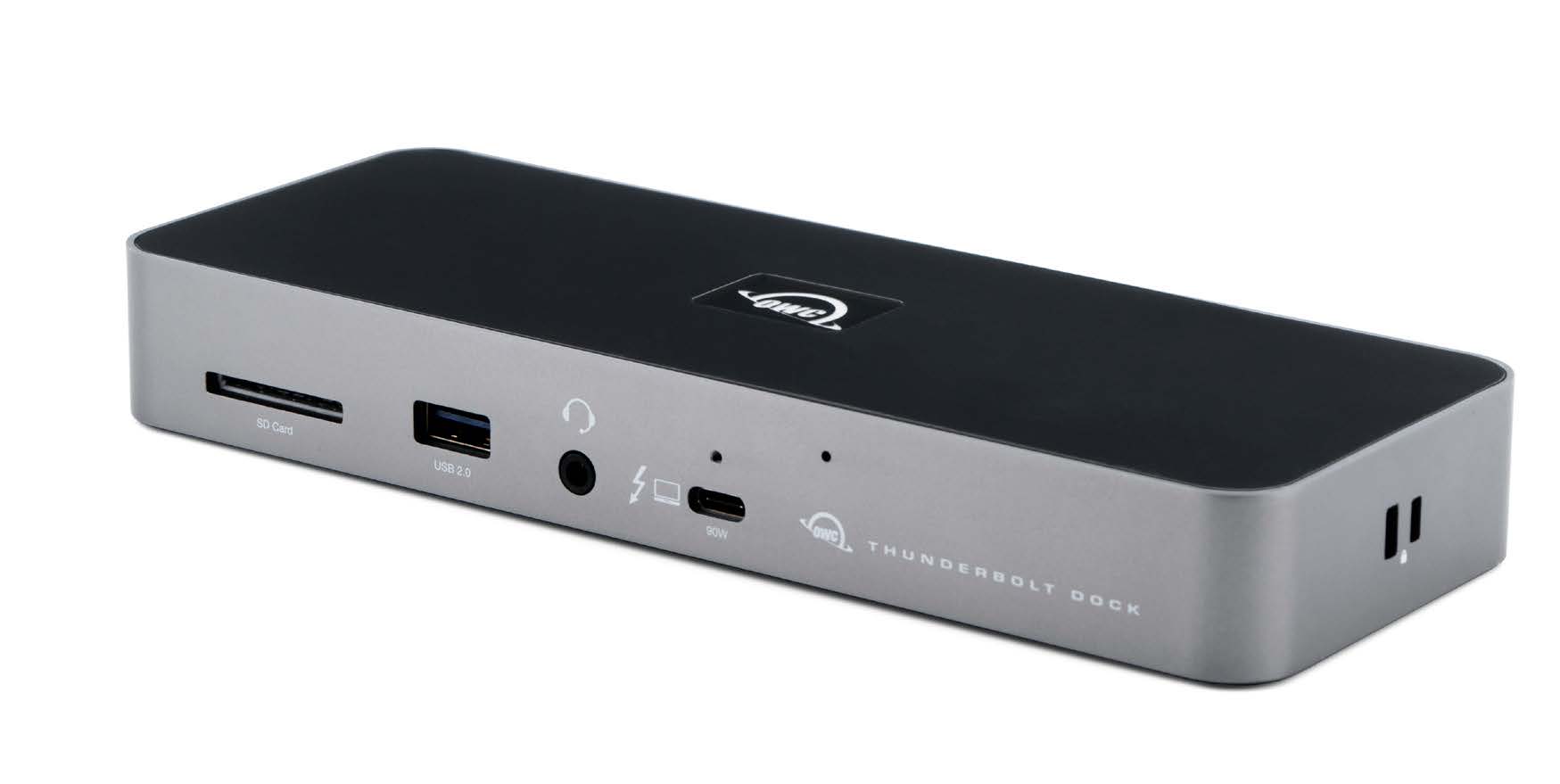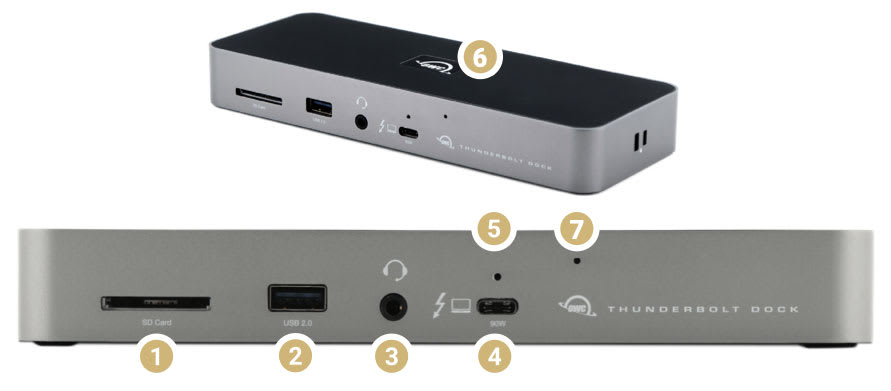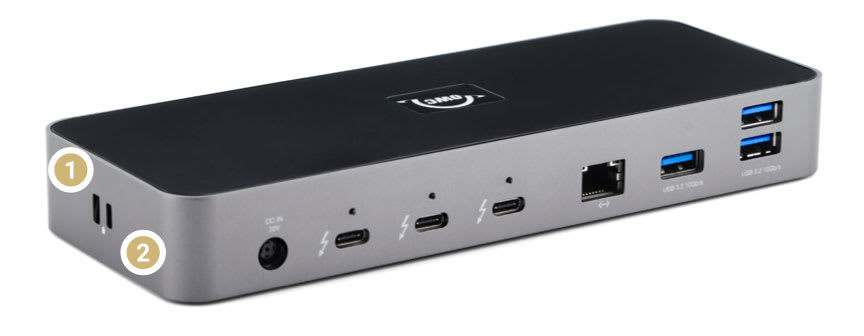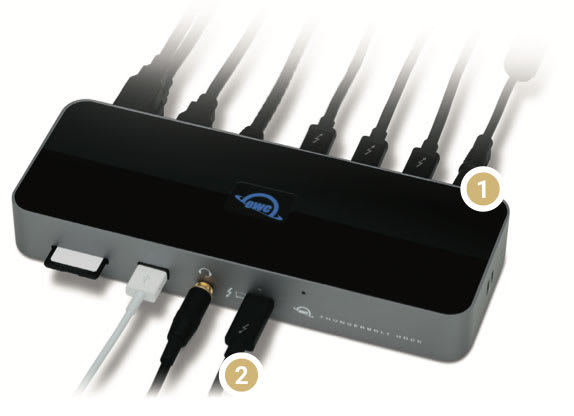OWC 11-Port Thunderbolt 4 Dock
Support Manual

Introduction
1.1 System Requirements
Operating System
- macOS 11.1 or later
- Windows 10 or later
Hardware
- Works with any Mac or PC with Thunderbolt 4
Supported Flash Media
- SD cards
1.2 Package Contents
- OWC Thunderbolt Dock
- Power adapter and cable
- Thunderbolt 4 cable
1.3 Front / Top Views
- SD Media slot – insert SD media card here. Speeds up to UHS-II are supported.
- USB 2.0 port – connect USB 2 peripherals like keyboards, mice, or printers here.
- Combo audio port – connect microphone or headphones with a 3.5mm connector here.
- Thunderbolt host port – connect to a Thunderbolt 3 or later port on a Mac, or Thunderbolt 4 port on a PC. Provides up to 96W of Power Delivery for laptop battery charging.
- ClingOn anchor – if you are using an OWC ClingOn to secure the Thunderbolt host cable, affix it here.
- LED – OWC logo will glow white when there is power but no data connection, or when the device enters Sleep mode. The logo will glow blue when there is power and an active data connection.
- LED Brightness control – by default the LED is set to a high brightness level. You can switch the LED to a lower brightness, or turn off the LED, by inserting the end of a paperclip to press the internal button. Minimal force is required. If you unplug the OWC Thunderbolt Dock from power, the LED will be reset to the default brightness level when power is reconnected.

1.4 Side View
- Kensington™ Security slot – if using a Kensington Security lock, attach here.
- Kensington Nano slot – If using a Kensington Nano lock, attach here.

1.5 Rear View
- DC IN – connect the included power supply here.
- Thunderbolt 4 ports – connect compatible Thunderbolt 4, Thunderbolt 3, or USB-C devices here. See Section 2.2 Usage Notes for display notes. Thunderbolt or Thunderbolt 2 devices can be connected via the Apple Thunderbolt 3 (USB-C) to Thunderbolt 2 adapter.
- ClingOn anchors – if you are using one or more OWC ClingOn anchors to secure the Thunderbolt 4, Thunderbolt 3, or USB-C device cable(s), affix them here.
- Gigabit Ethernet port – connect Ethernet cable here.
- USB 3.2 Type-A ports – connect compatible USB devices here. Speeds up to 10Gb/s supported. See Section 2.2 Usage Notes for limitations.

Getting Started
2.1 Device Setup
- Connect the Thunderbolt Dock to power using the included power supply and cable.
- Connect the dock to a Thunderbolt 3 or USB 4 port on Mac, or a Thunderbolt 4 port on PC.
- Connect other devices to the appropriate ports on the dock. All connected devices will be available for immediate use on your computer.

Device Management
3.1 Innergize Software
A software application included with OWC Atlas media cards that currently provides three basic functionalities to the user: Health, Sanitize and Field Firmware Upgradability.
- The Health function allows the user to know how much life is left on their OWC Atlas media card
- Sanitize removes ghost data on OWC Atlas media cards which will allow the media cards to perform at their peak and out of factory condition performance in matter of seconds
- Field Firmware upgradability allows OWC to deliver live updates to our memory cards without the hassle of sending them in for an update.
Installing OWC Innergize
- Download OWC Innergize application based on the system:
- Open the downloaded Innergize.dmg file to begin and complete the installation process.
- For additional information regarding OWC Innergize please consult the support manual "OWC Innergize User Guide"
Required Firmware Update
OWC Innergize requires a firmware update to work properly with select OWC Memory Card Readers, Docks, and Storage Solutions.
- Ensure the OWC Thunderbolt 4 Dock (11-Port) is powered and connected to a compatible system with the included data cable.
- Insert an OWC Atlas SDXC memory card into the SD Media Slot of the OWC Thunderbolt 4 Dock (11-Port). Align the memory card notches with the internal card reader connections. The gold contacts should be facing left when the memory card is inserted. This allows the system to recognize the card reader.
Windows Users
- Download the OWC Innergize Firmware Update for the OWC Thunderbolt 4 Dock (11-Port).
- Access the system Downloads folder and open the downloaded Compressed Folder. The compressed folder will open showing a firmware updater folder, and PDF/Word instructions for completing the firmware update process. Before accessing the firmware updater folder, open the instructions and proceed through the provided steps.
Mac Users
- Additional steps are required to complete the installation of the firmware. The firmware update is completed through the Windows operating system, therefore a Windows operating system emulator “Parallels” will need to be downloaded.
- For additional information regarding the OWC Innergize for Mac firmware update please consult the support article based on the system: "Innergize for Mac: Firmware Update".
3.2 Unmounting Volumes
To ensure no data is lost during normal use, always eject or unmount the corresponding volumes(s) from your operating system before powering off the device. Unmounting options are provided below.
Dock Ejector
This application safely ejects all drives connected to the OWC 11-Port Thunderbolt 4 Dock with a single click, adding peace of mind to fast-paced mobile workflows. To install this app, please follow the steps below.
- Download the installer file for Mac: go.owc.com/dockejector
- Launch the installer and follow the prompts. No restart is required.
- Once the app is running an icon like the one shown below will appear in the macOS menubar. Clicking on the icon will provide options to unmount the OWC ThunderBay Flex 8.
- Full user manual can be viewed by visiting go.owc.com/dockejector/manual
Manually Unmounting Volumes
- To ensure no data is lost during normal use, always eject or unmount the corresponding volume(s) from the operating system before powering off and disconnecting the device. Unmounting options are provided below.
macOS
- Drag the icon for the device you wish to unmount to the trash can; OR
- Right-click the device icon on the desktop, then click “Eject”; OR
- Highlight the device on your Desktop and press Command-E.
Windows
- Windows 10 build 1809 (October 2018) or later:
- Eject the drive by clicking the ‘Show hidden items’ menu in the Taskbar, then clicking ‘Safely Remove Hardware and Eject Media’, and last select the ‘Eject’ option for this volume.
- Windows 10 build 1803 and earlier:
- Go to the System Tray (located in the lower right corner of your screen). Click on the “Eject” icon (a small green arrow over a hardware image).
- A message will appear, detailing the devices that the “Eject” icon controls, i.e., “Safely remove...” Click on this prompt.
- You will then see a message that says, “Safe to Remove Hardware.” It is now safe to disconnect the device from the computer.
3.3 Usage Notes
- Works with Thunderbolt 4, Thunderbolt 3, USB4, and USB host computers and mobile devices.
- Thunderbolt 4 is capable of supporting up to two external displays from a single system host port dependent on the host system’s capability. Thunderbolt 4 external display support includes up to two 4K displays @ 60Hz, or one 8K display @ 60Hz.Display support, including available resolution and refresh rates, is dependent on host hardware and drivers.
- Please review the Apple silicon External Display Support support article for more details regarding performance how many external displays can be connected to an Apple silicon Mac system.
- Higher refresh rates (above 60Hz) may require DSC (Display Stream Compression) support on the monitor. DSC support is required for 6K and 8K resolutions.
- Apples's Pro 6K XDR Display is not supported. Apple recommends connecting the included Thunderbolt 3 Pro Cable (2 m) to the Thunderbolt 3 port on your display and a Thunderbolt 3 port directly on your Mac, not daisy-chained through another Thunderbolt 3 device or hub.
- Mac Users: A software driver is required to enable Apple Super Drive, Apple USB Keyboard, and for charging iPad generations 1, 2 and 3. This driver is included in the OWC Dock Ejector software download package. If your SuperDrive doesn't respond when connected to an external display or USB hub, connect your SuperDrive to a USB port directly on your Mac.
- Recorded sound input playback will be quiet. Adjusting the input volume in System Preferences does not improve the softness of the recording playback. Connecting the desired input directly into the computer system will improve the recorded sound input.
- The UltraStudio Recorder 3G is not compatible with the OWC 11-Port Thunderbolt Dock. System Report will show the device being connected; however, the driver won’t load which doesn’t allow for use of the device. The UltraStudio Recorder 3G works properly when directly connected to a system.
- A firmware update is required to use OWC 11-Port Thunderbolt Dock with OWC Innergize software. Please consult the "Innergize for PC: Firmware Update" or "Innergize for Mac: Firmware Update" guide for download and installation instructions.
- No jumbo frame support.
- Connected Thunderbolt and USB connected external drive solutions may remain powered on for a short duration of up to 10 minutes when the host system is asleep/powered off or when the dock/hub is physically disconnected from a system. Connected external drive solutions may get warm as they remain powered on. The temperature remains within a normal operation range and has no short or long-term effects on the device or drive.
- OWC Envoy Pro Elektron and OWC Envoy Pro FX devices remain powered on when the host system is asleep/powered off or when the dock/hub is physically disconnected from a system. These devices may get warm as they remain powered on however, the temperature remains within a normal operation range and has no short or long-term effects on the device, drive, or performance.
- There is no power switch on the dock. As long as it is connected to power and to a computer, the dock will function. If the computer powers off or sleeps, the dock will remain powered on, but all other devices connected through the dock will power off or sleep, as if they were connected directly to the computer.
- For the USB Type-A ports on the back of the device, connecting to only one of them will allow for maximum performance. As you plug in additional USB devices, the bandwidth will be shared among them. This is also true when you use the audio port, SD media slot, and Ethernet port; all three share the same bandwidth as the USB ports.
- For Mac Customers, this Thunderbolt 4 device is backward compatible with Thunderbolt 3 computers running macOS 11.1 or later, and with Thunderbolt 3 devices connected to the back of the dock. For PC Customers, this device will only work with Thunderbolt 4 computers, but does allow for Thunderbolt 3 devices to be connected to the back of the dock.
- All downstream Thunderbolt ports on this device provide up to 15W bus power for compatible Thunderbolt and USB-C peripherals.
- Thunderbolt device chains can support up to six Thunderbolt devices, thus five additional Thunderbolt devices can be chained to the Thunderbolt Dock. A Thunderbolt 4 or Thunderbolt 3 display (or a display connected via a USB-C display adapter) can be added to the end of a device chain.
Display Notes
- It is possible to use other types of display connections (such as HDMI and DisplayPort) with an available Thunderbolt 4 port, so long as you have the appropriate USB-C display adapter or adapter cable. Certified DisplayPort cables and adapters are not specific to any one version of the specification. For HDMI make sure both the adapter or cable, and the display, match the same HDMI specification.
- 8K resolutions are part of the DisplayPort 1.4 specification, which is supported by the OWC Thunderbolt Dock. However 8K setups are only possible when both the host computer and display also offer full support for this specification. At the time of this writing we are not aware of any Mac computers which support 8K 60Hz (or 4K 120Hz) setups; tests are ongoing. This document will be updated as Macs with 8K display support are confirmed.
- Please review the manufacturer specifications to determine your display’s capabilities.
- Some Mac hosts offer only partial support for DisplayPort 1.4, limiting the resolution to (for example) 5K or 6K at 60Hz. Please review Apple’s display specifications for your specific Mac to determine the maximum supported resolution and color depth.
- The following Apple M1 (Apple Silicon) Macs support only a single display over Thunderbolt. Dual display configurations are possible with the Mac mini via the additional built-in HDMI 2.0 port:
- MacBook Pro (13-inch, M1, 2020) - MacBookPro17,1
- MacBook Air (M1, 2020) - MacBookAir10,1
- Mac mini (M1, 2020) - Macmini9,1
Support Resources
4.1 Troubleshooting
Begin troubleshooting by verifying that the power cable is connected to the OWC Thunderbolt Dock and to a power source. If the power cable is connected to a power strip, make sure that the power switch on the strip is on. Next, verify that both ends of the Thunderbolt 4 cable are properly plugged into the computer and the dock. If the dock is still not working properly, try using a different Thunderbolt 4 cable or using another Thunderbolt port on the computer.
You can verify if the dock is recognized by the host computer by using one of the methods below.
- Mac: Open the System Information / System Report from the About this Mac window, click the Thunderbolt item in the sidebar, and then look for the Thunderbolt Dock item in the device tree that appears. If you do not see it initially, try pressing Cmd-R and waiting a few seconds to refresh the list.
- PC: Open the Device Manager, locate the ‘Thunderbolt Controller’ item, and then see if the dock is listed as a sub-item.
If the dock is listed in the applicable system area but one or more connected devices are still not available to the system, trouble-shoot each device individually. If the dock is still not recognized by the system, please contact our Support Team.
4.2 Contacting Support
4.3 About This Manual
The images and descriptions may vary slightly between this manual and the unit shipped. Functions and features may change depending on the firmware version. The latest product details and warranty information can be found on the product web page. OWC’s Limited Warranty is not transferable and
General Use Precautions
- To avoid damage, do not expose the device to temperatures outside the following ranges:
- Environmental (Operating)
- Temperature (ºF): 41º — 95º
- Temperature (ºC): 5º — 35º
- Environmental (Non-Operating)
- Temperature (ºF): -4º — 140º
- Temperature (ºC): -20º — 60º
- Environmental (Operating)
- Always unplug the device from the electrical outlet if there is a risk of lightning or if it will be unused for an extended period-of-time. Otherwise, there is an increased risk of electrical shock, short-circuiting, or fire.
- Protect your device from excessive exposure to dust during use or storage. Dust can build up inside the device, increasing the risk of electrical shock, short-circuiting, or fire.
- Do not block any ventilation openings on the device. These help to keep the device cool during operation. Blocking the ventilation openings may increase the risk of electrical shock, short-circuiting, or fire.
Safety Precautions
- Use proper anti-static precautions when handling this device. Failure to do so can increase the risk of electrical shock or short-circuiting.
- Never expose your device to rain, or use it near water, or in damp wet conditions. Never place objects containing liquids on the device, as they may spill everywhere and into the openings. This will increase the risk of electrical shock, short-circuiting, fire, or personal injury.
- To avoid any risk of electrical shock, short-circuiting, fire, or dangerous emissions, never insert any metallic object into the device.
- Please cease use of the device and contact OWC Support if it appears to be malfunctioning.
Terms & Conditions of Sale
Warranty
The OWC 11-Port Thunderbolt 4 Dock has a 2 Year OWC Limited Warranty. For up-to-date product and warranty information, please visit the product web page.
Changes
The material in this document is for information purposes only and subject to change without notice. While reasonable efforts have been made in the preparation of this document to assure its accuracy, OWC, its parent, partners, affiliates, officers, employees, and agents assume no liability resulting from errors or omissions in this document, or from the use of the information contained herein. OWC reserves the right to make changes or revisions in the product design or the product manual without reservation and without obligation to notify any person of such revisions and changes.
FCC Statement
Warning! Modifications not authorized by the manufacturer may void the user’s authority to operate this device.
Note: This equipment has been tested and found to comply with the limits for a Class A digital device, pursuant to Part 15 of the FCC Rules. These limits are designed to provide reasonable protection against harmful interference when the equipment is operated in a commercial environment. This equipment generates, uses, and can radiate radio frequency energy and, if not installed and used in accordance with the instruction manual, may cause harmful interference with radio communications. Operation of this equipment in a residential area is likely to cause harmful interference, in which case the user will be required to correct the interference at his own expense.
Note: This equipment has been tested and found to comply with the limits for a Class B digital device, pursuant to Part 15 of the FCC Rules. These limits are designed to provide reasonable protection against harmful interference in a residential installation. This equipment generates, uses and can radiate radio frequency energy and, if not installed and used in accordance with the instructions, may cause harmful interference to radio communications. However, there is no guarantee that interference will not occur in a particular installation. If this equipment does cause harmful interference with radio or television reception, which can be determined by turning the equipment off and on, the user is encouraged to try to correct the interference by one or more of the following measures:
- Reorient or relocate the receiving antenna.
- Increase the separation between the equipment and receiver.
- Connect the equipment to an outlet on a circuit different from that to which the receiver is connected.
Copyrights And Trademarks
No part of this publication may be reproduced, stored in a retrieval system, or transmitted in any form or by any means, electronic, mechanical, photocopying, recording or otherwise, without the prior written consent of OWC.
© 2020 Other World Computing, Inc. All rights reserved. OWC and the OWC logo are trademarks of New Concepts Development Corporation, registered in the U.S. and/or other countries. Apple, Mac, mac OS, and SuperDrive are trademarks of Apple Inc., registered in the United States and other countries. Kensington, ACCO, and Kensington Nano Security Slot are registered trademarks of ACCO Brands Corporation. Thunderbolt and the Thunderbolt logo are trademarks of Intel Corporation in the U.S. and/or other countries. Microsoft and Windows are either registered trademarks or trademarks of Microsoft Corporation in the United States and/or other countries. Other marks may be the trademark or registered trademark property of their owners.
Free Support Chat
Our free award-winning support team is ready to answer all of your questions. Technical support is available Monday - Friday: 9AM - 6PM. Customer Support & Sales is available Monday - Friday: 9AM - 6PM. Support is unavailable on U.S. Federal holidays. Talk to a human today.

 1-800-275-4576
1-800-275-4576